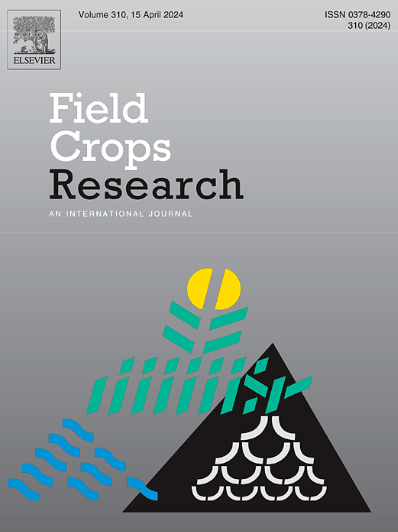Coupled effects of rainfall-induced soil moisture and nitrogen placement depth on maize productivity and resource utilization in the Loess Plateau
IF 5.6
1区 农林科学
Q1 AGRONOMY
引用次数: 0
Abstract
Context and objectives
While deep nitrogen fertilization represents a well-established agronomic practice for enhancing yield stability by synchronizing nutrient availability with crop demand, the interactive effects of precipitation patterns and fertilization depth on crop performance and resource use efficiency remain poorly quantified, particularly in precipitation-sensitive dryland agroecosystems. Therefore, understanding how rainfall-driven soil moisture dynamics interact with the spatial distribution of soil nutrients to influence crop yield and resource use efficiency is critically important for improving the sustainability and productivity of dryland agricultural systems.
Methods
A field experiment was conducted from 2019 to 2022 to evaluate the effects of various nitrogen fertilizer placement depths [5 cm (D5), 15 cm (D15), 25 cm (D25), 35 cm (D35)] and different yearly rainfall patterns on the yield, crop water productivity and nitrogen use efficiency (i.e., WP and NUE), and net economic benefits (NEB) in dryland maize.
Results
Compared to long-term precipitation trends, crops received significantly higher amounts of precipitation during 2019 and 2020 growing seasons, but experienced a markedly drier growing season in 2022. Our results indicated that total seasonal precipitation and fertilizer placement depth had significant (P < 0.05) effects on grain yield, WP, NUE and NEB. In the wetter seasons (i.e., 2019 and 2020), the highest grain yield, WP, NUE and NEB were observed under D25, exceeding D5 by 13.83 %, 11.89 %, 38.37 % and 13.71 %, respectively. In the drier season (i.e., 2022), the best performances in grain yield, WP, NUE and NEB were achieved under D35, which were 26.12 %, 16.58 %, 51.58 % and 25.53 % higher than those under D5, respectively.
Conclusions
Our findings reveal a clear relationship between optimal fertilization depth and rainfall conditions. Specifically, a nitrogen application depth of 35 cm during drier growing seasons significantly improves maize yield, resource use efficiency, and economic returns. In contrast, a 25 cm placement is more effective in wetter years, optimizing productivity while minimizing the risk of nutrient leaching. This precipitation-responsive fertilization strategy represents a promising climate-adaptive practice, with the potential to improve both productivity and economic sustainability in semiarid maize cropping systems.
降雨诱导土壤水分和施氮深度对黄土高原玉米生产力和资源利用的耦合效应
背景和目标虽然深层氮肥是一种成熟的农艺做法,通过同步养分有效性和作物需求来提高产量稳定性,但降水模式和施肥深度对作物性能和资源利用效率的相互作用仍然缺乏量化,特别是在对降水敏感的旱地农业生态系统中。因此,了解降雨驱动的土壤水分动态如何与土壤养分的空间分布相互作用,从而影响作物产量和资源利用效率,对于提高旱地农业系统的可持续性和生产力至关重要。方法采用2019 ~ 2022年的田间试验,评价不同施氮深度[5 cm (D5)、15 cm (D15)、25 cm (D25)、35 cm (D35)]和不同年降雨量模式对旱地玉米产量、作物水分生产力、氮素利用效率(WP和NUE)以及净经济效益(NEB)的影响。结果与长期降水趋势相比,2019年和2020年作物生长季降水量显著增加,但2022年作物生长季明显干旱。结果表明:季节总降水量和施肥深度对籽粒产量、WP、NUE和NEB有显著影响(P <; 0.05),在湿润季节(2019年和2020年),D25处理的籽粒产量、WP、NUE和NEB最高,分别比D5处理高出13.83 %、11.89 %、38.37 %和13.71 %。在干旱季节(即2022年),D35处理在籽粒产量、WP、NUE和NEB方面表现最佳,分别比D5处理提高26.12 %、16.58 %、51.58 %和25.53 %。结论最佳施肥深度与降雨条件之间存在明显的关系。旱季施氮深度为35 cm可显著提高玉米产量、资源利用效率和经济效益。相比之下,在潮湿的年份,25厘米的放置更有效,优化生产力,同时最大限度地减少养分淋失的风险。这种响应降水的施肥策略是一种很有前景的气候适应做法,有可能提高半干旱玉米种植系统的生产力和经济可持续性。
本文章由计算机程序翻译,如有差异,请以英文原文为准。
求助全文
约1分钟内获得全文
求助全文
来源期刊

Field Crops Research
农林科学-农艺学
CiteScore
9.60
自引率
12.10%
发文量
307
审稿时长
46 days
期刊介绍:
Field Crops Research is an international journal publishing scientific articles on:
√ experimental and modelling research at field, farm and landscape levels
on temperate and tropical crops and cropping systems,
with a focus on crop ecology and physiology, agronomy, and plant genetics and breeding.
 求助内容:
求助内容: 应助结果提醒方式:
应助结果提醒方式:


